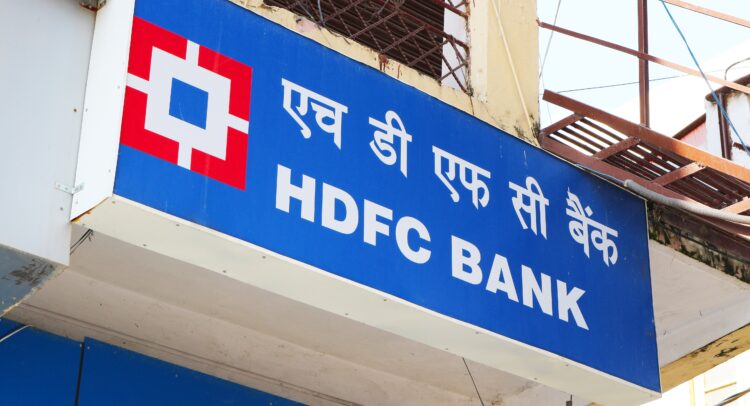HDFC Bank (NYSE:HBD) became one of the most valuable financial institutions in the world in 2023 following the merger with HDFC Ltd — India’s premier housing finance company. However, the stock hasn’t impressed investors since the merger due to a stretched valuation and falling margins. While I appreciate the long-term trends behind investing in one of India’s premier institutions, I’m neutral on HDFC Bank.
HDFC Is a New Beast, But Investors Aren’t Keen
HDFC Bank’s merger with HDFC Ltd created a new beast of the banking world, but this has not been met with investor enthusiasm — the stock is down 8.7% over the past 12 months. Interestingly, the stock has actually performed rather well since Prime Minister Narendra Modi’s ruling alliance suffered an election shock in the spring, slumping to a slim majority, which caused many international investors to pull out of Indian stocks.
One reason for the stock’s general underperformance over the past year is the shift in the net interest margin (NIM). Before the merger, the bank’s NIM was around 4.1%, but this has since fallen to 3.5% because of the change in the loan composition.
HDFC was previously proportionately more exposed to retail loans, including lucrative credit card debt, but has now become more focused on wholesale loans. Additionally, the merger with HDFC has introduced a significant number of low-yielding mortgage loans, further pressuring NIMs.
Another concern is the reduction in low-cost Current Account and Savings Account (CASA) deposits, falling from 42% to 38%. While this is concerning, some analysts have suggested that CASA deposits could increase as new HDFC Ltd customers — only 35% of HDFC’s customers previously had an HDFC Bank account — open accounts to service their outstanding HDFC Ltd loans. This would also serve as a source of cheap capital.
Collectively, these factors mean that the bank’s Return on Equity (ROE) has dropped to 15.8%. That’s down from levels above 17%+ and puts it in line with banks operating in more mature economies such as the U.S. and the UK.
Is HDFC a Bet on India?
HDFC can offer international investors exposure to the Indian economy as a cyclical stock with a large number of loans and mortgages within the portfolio. India is poised to be one of the world’s fastest-growing economies throughout the medium and long run, benefitting from something called a demographic dividend.
A demographic dividend occurs when a country has a high ratio of working-age individuals compared to dependents. This creates an economic surplus that allows for reinvestment and attracts further investment due to abundant labor. India’s demographic dividend is expected to peak in the years between 2020 and 2040, presenting a golden period for economic growth and Indian companies if harnessed effectively.
Harnessing this dividend involves ensuring a healthy, educated, skilled, and willing workforce. This requires addressing the fact that 90% of jobs in India are informal and that only 20% of working-age women are employed. Additionally, only 3% of the workforce has formal training, which, coupled with widespread health issues, including malnutrition and anaemia, presents significant challenges.
As a leading financial institution, HDFC stands to gain from the positive economic effects of a properly harnessed demographic dividend. As the state reinvests economic surplus and attracts foreign investment through initiatives like ‘Make in India,’ companies and banks like HDFC can benefit from increased economic activity and financial inclusion.
Indian economic growth was recently revised upward for the 2023-24 fiscal year to 8.2%. This is the highest among large economies globally and is up from an earlier government estimate of 7.6%.
HDFC’s Valuation Doesn’t Scream “Buy”
HDFC is currently trading at 19.6x non-GAAP earnings, putting it at an 88.1% premium to the sector as a whole. This is hugely expensive for a bank that operates in a developing economy. Moreover, the figures don’t suggest an improving picture. The non-GAAP forward price-to-earnings (P/E) ratio is 22.5x for 2025, 19.2x for 2026, and 20.2x for 2027. The price-to-book (P/B) ratio also sits at 2.72x, representing a 140% premium to the sector.
Is HDFC A Buy, According To Analysts?
On TipRanks, HDFC comes in as a Moderate Buy based on one Buy, zero Holds, and zero Sell ratings assigned by analysts in the past three months. There is no price target set by the analysts covering this stock.

The Bottom Line on HDFC Stock
HDFC stock is an interesting proposition. India is the fastest-growing large economy in the world, and investing in a cyclical stock, like a bank, provides exposure to this fast pace of growth. However, from a long-term perspective, it’s important to recognize that India’s economy also faces several hurdles if it is to deliver the promised economic growth and harness its demographic dividend.
However, HDFC has failed to impress investors since the merger. The company’s NIM has fallen, and to date, CASA deposits have trended downward. The result is a suffering ROE, which makes it hard to justify the stock’s valuation.
















